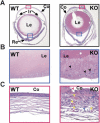Early aging and age-related pathologies in mice deficient in BMAL1, the core componentof the circadian clock
- PMID: 16847346
- PMCID: PMC1522083
- DOI: 10.1101/gad.1432206
Early aging and age-related pathologies in mice deficient in BMAL1, the core componentof the circadian clock
Abstract
Mice deficient in the circadian transcription factor BMAL1 (brain and muscle ARNT-like protein) have impaired circadian behavior and demonstrate loss of rhythmicity in the expression of target genes. Here we report that Bmal1(-/-) mice have reduced lifespans and display various symptoms of premature aging including sarcopenia, cataracts, less subcutaneous fat, organ shrinkage, and others. The early aging phenotype correlates with increased levels of reactive oxygen species in some tissues of the Bmal1(-/- )animals. These findings, together with data on CLOCK/BMAL1-dependent control of stress responses, may provide a mechanistic explanation for the early onset of age-related pathologies in the absence of BMAL1.
Figures




Similar articles
-
Effect of premature aging on murine adipose tissue.Exp Gerontol. 2012 Mar;47(3):256-62. doi: 10.1016/j.exger.2012.01.001. Epub 2012 Jan 12. Exp Gerontol. 2012. PMID: 22265801
-
Dual role of the CLOCK/BMAL1 circadian complex in transcriptional regulation.FASEB J. 2006 Mar;20(3):530-2. doi: 10.1096/fj.05-5321fje. Epub 2006 Jan 25. FASEB J. 2006. PMID: 16507766
-
The clock proteins, aging, and tumorigenesis.Cold Spring Harb Symp Quant Biol. 2007;72:477-82. doi: 10.1101/sqb.2007.72.050. Cold Spring Harb Symp Quant Biol. 2007. PMID: 18419307 Review.
-
Timing of expression of the core clock gene Bmal1 influences its effects on aging and survival.Sci Transl Med. 2016 Feb 3;8(324):324ra16. doi: 10.1126/scitranslmed.aad3305. Epub 2016 Feb 3. Sci Transl Med. 2016. PMID: 26843191 Free PMC article.
-
A role of the circadian system and circadian proteins in aging.Ageing Res Rev. 2007 May;6(1):12-27. doi: 10.1016/j.arr.2007.02.003. Epub 2007 Feb 21. Ageing Res Rev. 2007. PMID: 17369106 Review.
Cited by
-
Improved locomotor recovery after contusive spinal cord injury in Bmal1-/- mice is associated with protection of the blood spinal cord barrier.Sci Rep. 2020 Aug 26;10(1):14212. doi: 10.1038/s41598-020-71131-6. Sci Rep. 2020. PMID: 32848194 Free PMC article.
-
Glutamate-Dependent BMAL1 Regulation in Cultured Bergmann Glia Cells.Neurochem Res. 2015 May;40(5):961-70. doi: 10.1007/s11064-015-1551-z. Epub 2015 Mar 7. Neurochem Res. 2015. PMID: 25749891
-
Involvement of stress kinase mitogen-activated protein kinase kinase 7 in regulation of mammalian circadian clock.J Biol Chem. 2012 Mar 9;287(11):8318-26. doi: 10.1074/jbc.M111.308908. Epub 2012 Jan 20. J Biol Chem. 2012. PMID: 22267733 Free PMC article.
-
Transgenic mice overexpressing glia maturation factor-β, an oxidative stress inducible gene, show premature aging due to Zmpste24 down-regulation.Aging (Albany NY). 2015 Jul;7(7):486-99. doi: 10.18632/aging.100779. Aging (Albany NY). 2015. PMID: 26232943 Free PMC article.
-
The circadian clock and pathology of the ageing brain.Nat Rev Neurosci. 2012 Mar 7;13(5):325-35. doi: 10.1038/nrn3208. Nat Rev Neurosci. 2012. PMID: 22395806 Free PMC article. Review.
References
-
- Arking R. Biology of aging, 2nd ed. Sinauer Associates; Sunderland, MA.: 1998.
-
- Balaban R.S., Nemoto S., Finkel T. Mitochondria, oxidants, and aging. Cell. 2005;120:483–495. - PubMed
-
- Bordone L., Guarente L. Calorie restriction, SIRT1 and metabolism: Understanding longevity. Nat. Rev. Mol. Cell Biol. 2005;6:298–305. - PubMed
-
- Bunger M.K., Walisser J.A., Sullivan R., Manley P.A., Moran S.M., Kalscheur V.L., Colman R.J., Bradfield C.A. Progressive arthropathy in mice with a targeted disruption of the Mop3/Bmal-1 locus. Genesis. 2005;41:122–132. - PubMed
Publication types
MeSH terms
Substances
Grants and funding
LinkOut - more resources
Full Text Sources
Other Literature Sources
Medical
Molecular Biology Databases
